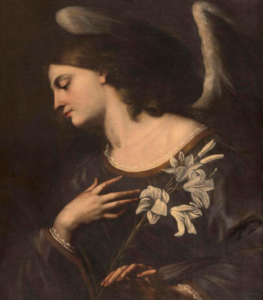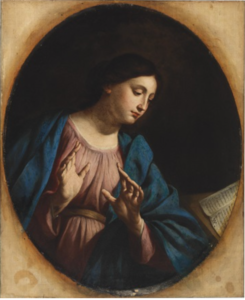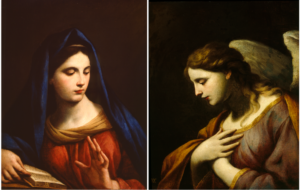Object of the Month: December 2022
The Virgin Annunciate and The Archangel Gabriel
Oil on canvas, Monogrammed: AV (lower left)
Andrea Vaccaro
Neapolitan, c 1605-1670
Andrea Vaccaro initially trained with the mannerist artist Girolamo Imparato, but was influenced by several other prominent artists of the time: Stanzione, Reni, Ribera, and van Dyck as well as the early Neapolitan Caravaggisti. During his lifetime he was in demand for church altarpieces, public works, and private commissions by the wealthy. According to historian Anna Kiyomi Tuck-Scala, he was elected “first prefetto of the renewed Corporation of Painters” in Naples in 1665, making “him a model religious painter of the period.”
Vaccaro’s pendant paintings portray the moment that the angel Gabriel announces that God has chosen Mary to be the Messiah’s earthly mother, a role that had been aspired to by countless Jewish maidens since the Fall of Man. Traditionally addressed by Gabriel in her bedchamber, Mary is usually reading Scripture, doing needlework. The angel often brings white lilies, signifying Mary’s purity.
Here Vaccaro instead focuses on the two actors. Since the Messiah is God’s Son come to earth to redeem humanity through His life, death, and resurrection, Vaccaro presents His mother as both exquisitely beautiful and devout. The sculptural smoothness of her face and neck, the delicate skin tones and the rich jewel colors of her attire combine to portray her as the ideal daughter of Israel. Though her upraised left hand betrays her startlement, her face remains serene. Being found at her devotions shows a spirit as lovely as her figure. Perhaps she is reading the book of Isaiah where the prophecy of the Messiah’s coming is given? Gabriel’s reverent facial expression reveals him to be cognizant of his role—and his news.
 While the figures are on separate canvases, the single light source and the chiaroscuro so associated with Caravaggio unite them in submission to God’s will: he as messenger, Mary as handmaid of the Lord. The earthly and heavenly come together, pre-figuring the Incarnation itself.
While the figures are on separate canvases, the single light source and the chiaroscuro so associated with Caravaggio unite them in submission to God’s will: he as messenger, Mary as handmaid of the Lord. The earthly and heavenly come together, pre-figuring the Incarnation itself.
Similar works are also attributed to Vaccaro. The Ackland Art Museum at Chapel Hill has a more “standard” Gabriel who holds a stalk of lilies. His hands are the long-fingered Mannerist hands of Vaccaro’s early training. Artnet’s version of Mary’s portrait appears to use the same model as M&G’s, but the addition of the neck drape on M&G’s Mary creates a more elegant, idealized portrait.
 The treatment of both Marys’ hands is intriguing. The left hands are similarly posed, but the right hand of Mary in the M&G’s collection (see above) is much fleshier, contrasting with the elongated fingers of the left. According to Riccardo Lattuada, Vaccaro used his monogram (clearly seen on Mary’s book) only during his “first mature stage, 1636-1640.” Perhaps the contrasting hands indicate the artist’s transition from his mannerist roots. If as Marchesa Vittoria Colonna suggests that “contemplation of religious paintings . . . encourage[s] meditation on the kingdom of heaven,” these companion works by Vaccaro indeed picture a beautiful moment in the history of the world—and of eternity—to ponder.
The treatment of both Marys’ hands is intriguing. The left hands are similarly posed, but the right hand of Mary in the M&G’s collection (see above) is much fleshier, contrasting with the elongated fingers of the left. According to Riccardo Lattuada, Vaccaro used his monogram (clearly seen on Mary’s book) only during his “first mature stage, 1636-1640.” Perhaps the contrasting hands indicate the artist’s transition from his mannerist roots. If as Marchesa Vittoria Colonna suggests that “contemplation of religious paintings . . . encourage[s] meditation on the kingdom of heaven,” these companion works by Vaccaro indeed picture a beautiful moment in the history of the world—and of eternity—to ponder.
Dr. Karen Rowe Jones, M&G Board Member & volunteer
Sources Cited:
Marchesa Vittoria Colonna, Marchesa Vittoria. The Bob Jones University Collection of Religious Paintings, 1962.
Tuck-Scala, Anna Kiyomi. “The Documented Paintings and Life of Andrea Vaccaro (1604-1670),” 2003.
Published 2022
